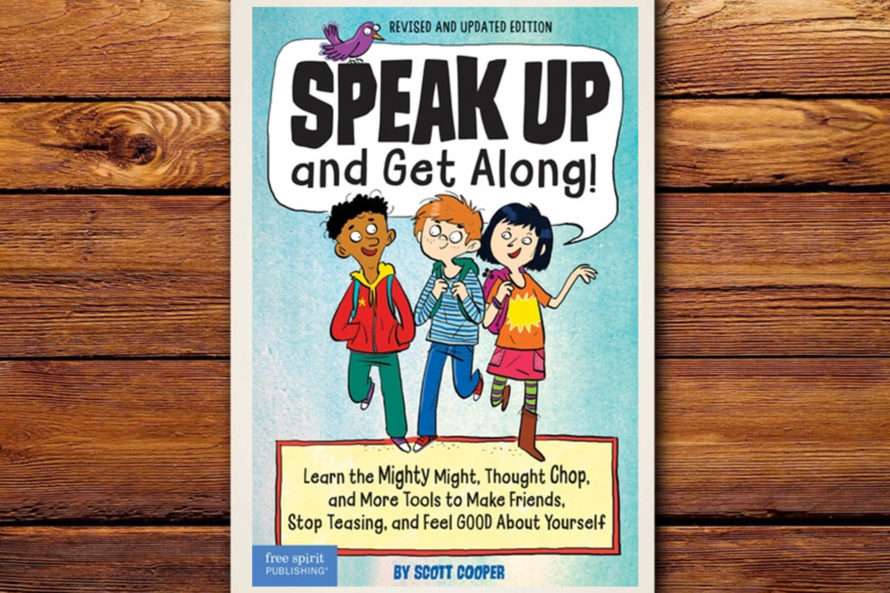All parents want their kids to get along with others, have friends, and stand up for themselves. For some children, these goals are harder to achieve than for others, and for children who are very shy or have social skills difficulties, it might feel like an impossible set of skills to master. These are the children who could benefit from this book.
Speak Up and Get Along is written for kids. It addresses the skills children need to get along with others and enjoy less conflict in their relationships. Written by Scott Cooper, an anti-bullying advocate and former teacher, the language is accessible, the examples are real, and he provides plenty of suggestions for how to practise the skills presented.
The book is organized into six main sections and presents the reader with 21 different tools for a variety of social situations and challenges. At the end are some notes for adults on how to help children deal with bullying, how to practise the skills presented, and further resources to consult if needed. It is a quick read with practical advice that is easy to follow. Below, I will summarize the six sections of the book and the tools presented.
Section 1: Expressing Yourself
This section deals with how to be assertive, defined on page 8 as “sticking up for yourself and others […] asking for what you need or deserve in a strong, confident way.”
- “The Power of I” (p. 9) – using “I-statements” to state what you think or feel, including confident body language and the best ways for self-advocating with both peers and adults
- “The No Thanks” (p. 13) – how to say no to peer pressure and how to be an independent thinker, even in the face of pressure to conform
- “Asking Questions” (p. 18) – helps youngsters ask for help or information and encourages them to think “What’s the worst that could happen?” as a way of getting over their nervousness about asking for help
- “The Squeaky Wheel” (p. 20) – being persistent and standing your ground without getting upset. However, the author warns that if you think the other person might pose a physical threat to you, the squeaky wheel tool would not be the best choice.
Section 2: Making and Keeping Friends
The second section starts by giving the reader eight practical strategies for becoming more comfortable talking to people, such as ordering for yourself in a restaurant, greeting people who come to your house, or joining a club or activity at school or in the community.
- “The Sherlock Holmes” (p. 27) – reminds children to ask questions as a way to start conversations and to really listen to the answers to show they’re interested in the other person
- “Sharing” (p. 32) – means giving information about yourself—without exaggerating or lying—to start or continue a conversation and then asking follow-up questions to see if this is something you have in common
- “Kind Talk” (p. 35) – showing respect and caring for the other person. It means “going out of your way to help others with your words” (p. 35) such as by being polite, giving compliments, offering support, or doing favours for others.
Section 3: Ending Arguments and Fights
In section three, Cooper reminds readers of two important things: 1) don’t argue about issues that aren’t worth it; and 2) working hard to resolve conflicts is what real leaders do.
- “The Coin Toss” (p. 43) (or drawing straws, picking a number, etc.) – a quick and fair way to solve minor, unimportant issues
- “Solution Time” (p. 44) – for larger issues where you both actively choose to resolve the problem, define the issue, collect ideas, choose a win-win solution that you can both agree on, and do it. For some problems that are not easily solved on your own, you might need a referee (such as an adult, older sibling, or other uninvolved party) to help you implement a collaborative approach to finding a solution.
- “Cool Down” (p. 50) – feelings happen faster than our brains can keep up with them, so before reacting to a problem or trying to find a solution, let our more reasonable, logical brain catch up.
Section 4: Stopping Teasing and Bullying
This section is different from the previous one because bullies are not interested in solving conflicts; they are only interested in getting control and power, and they intentionally start conflicts in order to achieve these goals. Readers are reminded that telling an adult when they are being teased or bullied is not the same as tattling and is often necessary to end physically or emotionally harmful situations.
First, we are advised to try to avoid being victimized by carrying ourselves with confidence and assertiveness and to try to keep the company of others rather than being alone on the school yard or walking home. If that does not work, Cooper suggests:
- “The Power of I for Teasing” (p. 58) – similar to the original Power of I in that you assert yourself to tell the other person that you don’t like the teasing and that they need to stop
- “The Shrug” (p. 60) – shows the bullies that you aren’t bothered by what they are saying. Act bored, walk away, smile or laugh at their verbal jabs to show that they don’t have any power over you
- “The Mighty Might” (p. 62) – saying that the bully might be right (e.g., “My glasses might make me look like a nerd.”) to give an unexpected reaction and take the wind out of the bully’s sails, leaving them without a further retort
For people who are brave, quick thinkers and who don’t think this will cause the bullying to escalate to physical threats:
- “The Comeback Kid” (p. 63) – being assertive and funny (and avoiding being mean). There are three sub-tools to The Comeback Kid
- “The Power of You” (p. 64) – puts the attention back on the bully by suggesting that there is something wrong with them instead of with the victim (e.g., “Nobody else seems to have a problem with this; I’m not sure why you do.”)
- “Complete Denial” (p. 66) –just say “No” to any insult (e.g., “No, my clothes aren’t weird” or “No, I’m not dumb.”)
- “I Can’t Hear You” (p. 67) – just not acknowledging the insult by blaming poor acoustics (e.g., “Sorry, I couldn’t quite hear what you said. We’ll have to talk later.”
Although none of the comebacks mentioned are mean-spirited or attack the bully, caution should be used that you don’t exacerbate the situation and give the bully a reason to escalate his or her behaviour towards you.
If the bullying becomes physical or you feel you could be in danger, Cooper suggests using “The Disappearing Act” (p. 69) to just get away from the situation. Get home, into a store, inside the school, or somewhere safe that the bully can’t get to you and call a friend or adult for support if necessary. Never try to fight a bully or put yourself in a situation where you will be hurt.
Section 5: Dealing with Blame
Taking responsibility for your mistakes is hard to do, but doing so shows that you have maturity and integrity.
- “The Mea Culpa” (p. 75) – accept responsibility, offer a heartfelt apology, and do something to make it right and restore the relationship
- “The No Way” (p. 77) – if you are being unfairly blamed, fess up to any part of the problem that you are truly responsible for (even if it was an accident) but communicate your innocence for anything that you did not do
Section 6: Talking Back to Negative Thoughts
Sometimes, our own negative self-talk can derail our efforts to do well in a wide variety of situations. We know that feelings and thoughts are closely related, so if you want to change how you feel about something, try changing how you think about it.
- “The But Twist” (p. 86) – if you are having trouble motivating yourself to do something you don’t particularly enjoy, take the negative thought (e.g., ”I don’t want to clean my room”) and add a positive twist starting with the word “but” (e.g., “but when I’m cleaning up I might find that special item I’ve been looking for”). You stop focusing on the negative feelings that are preventing you from getting started and instead focus on the positive thoughts.
- “The Thought Chop” (p. 89) – some children get hung up on “Things-Are-Terrible Thoughts” (p. 89) and they catastrophize even small problems. These are usually the result of five common “thinking mistakes” (pp. 90-92): exaggerating, seeing only the bad, assuming the worst outcome, mistakenly blaming yourself, and stereotyping or mislabeling. If you are suffering from “Things-Are-Terrible Thoughts”, you can consider the feeling you are experiencing, and then use the thought chop to stop the thinking mistake and replace it with a more objective statement. For example, if you did poorly on a science test and are thinking that you’re dumb, you can use the thought chop to tell yourself that even though science is a difficult subject for you, you do very well in math and geography. Or else you can say that even though you did poorly on this one test, you know you can study more and get a better grade on the next assignment.
- “Solution Time 2” (p. 96) – for solving internal problems, use the same steps as when you are solving a conflict with a peer. You can use solution time to reflect honestly about the problems that are causing you to experience unhappy feelings and then brainstorm possible solutions and try one.
- “The Balloon Belly” (p. 98) – using mindfulness to calm your body in order to calm your thoughts. There are many ways to physically calm yourself including exercise, rest, or leisure activities, but if your mind is still racing, you may need to try some mindful breathing, imagining that with every exhalation you are releasing the bad thoughts and making room for calm.
I enjoyed this book, especially the suggestions for how to practise these tools and the embedded dialogues to demonstrate the problems the tools are meant to solve. It is easy to apply what you are reading about, either in simulations, social skills groups, or in real life. The reading level is indicated at grade 4, and the interest level is ages 8-12, but I think you could easily use these strategies with younger or older children. A worthwhile resource to add to your parenting toolkit.

